- Clone
- 1F4 (See other available formats)
- Regulatory Status
- RUO
- Other Names
- T cell antigen receptor complex, T3
- Isotype
- Mouse IgM, κ
- Ave. Rating
- Submit a Review
- Product Citations
- publications
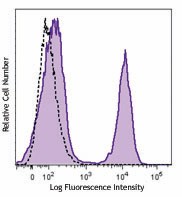
-

Lewis rat splenocytes were stained with CD3 (clone 1F4) PE (filled histogram) or mouse IgM, κ PE isotype control (open histogram).
| Cat # | Size | Price | Quantity Check Availability | Save | ||
|---|---|---|---|---|---|---|
| 201411 | 25 µg | $92 | ||||
| 201412 | 100 µg | $161 | ||||
CD3 is a complex composed of δ, γ, ε, and ζ chains. They are 20-25 kD members of the immunoglobulin superfamily and associated with the T cell receptor (TCR). CD3 is expressed on thymocytes, peripheral T cells, some NK-T cells, and dendritic epidermal T cells. CD3 is involved in antigen recognition, signal transduction, and T cell activation.
Product DetailsProduct Details
- Verified Reactivity
- Rat
- Antibody Type
- Monoclonal
- Host Species
- Mouse
- Immunogen
- F344 rat spleen cells stimulated with PMA and calcium ionophore
- Formulation
- Phosphate-buffered solution, pH 7.2, containing 0.09% sodium azide.
- Preparation
- The antibody was purified by affinity chromatography and conjugated with PE under optimal conditions.
- Concentration
- 0.2 mg/ml
- Storage & Handling
- The antibody solution should be stored undiluted between 2°C and 8°C, and protected from prolonged exposure to light. Do not freeze.
- Application
-
FC - Quality tested
- Recommended Usage
-
Each lot of this antibody is quality control tested by immunofluorescent staining with flow cytometric analysis. For flow cytometric staining, the suggested use of this reagent is ≤0.5 µg per million cells in 100 µl volume. It is recommended that the reagent be titrated for optimal performance for each application.
- Excitation Laser
-
Blue Laser (488 nm)
Green Laser (532 nm)/Yellow-Green Laser (561 nm)
- Application Notes
-
Immobilized 1F4 antibody can induce T cell proliferation in vitro. Additional reported applications (for relevant formats of this clone) include: immunohistochemistry of acetone-fixed frozen sections1 and formaldehyde- fixed paraffin embedded sections4,5 immunofluorescence microscopy3, in vivo activation of T cell responses1, and in vivo inhibition of T cell responses2.
-
Application References
(PubMed link indicates BioLegend citation) -
- Tanaka T, et al. 1989. J. Immunol. 142:2791. (Activ, IHC, IP)
- Nicholls MR, et al. 1993. Transplantation 55:459. (Block)
- Elbe A, et al. 1993. J. Invest. Dermatol. 102:74. (IF)
- Baba T, et al. 2006. Blood 107:2004. (IHC)
- Fujishiro J, et al. 2010. Am. J. Transplant. 10:1545-55. (IHC-P)
- Li X, et al. 2009. J. Immunol. 183:3955. (FC) PubMed
- Product Citations
-
- RRID
-
AB_2563272 (BioLegend Cat. No. 201411)
AB_2563273 (BioLegend Cat. No. 201412)
Antigen Details
- Structure
- Ig superfamily, approximately 20-25 kD
- Distribution
-
Thymocytes, peripheral T cells, dendritic epidermal T cells, NK-T cells
- Function
- Antigen recognition, TCR signal transduction, T cell activation
- Ligand/Receptor
- Peptide antigen/MHC complex
- Cell Type
- NKT cells, T cells, Thymocytes
- Biology Area
- Immunology
- Molecular Family
- CD Molecules
- Antigen References
-
1. Tanaka T, et al. 1989 J. Immunol. 142:2791.
2. Elbe A, et al. 1993. J. Invest. Dermatol. 102:74. - Gene ID
- 25710 View all products for this Gene ID 300678 View all products for this Gene ID 315609 View all products for this Gene ID 25300 View all products for this Gene ID
- UniProt
- View information about CD3 on UniProt.org
Related FAQs
- What type of PE do you use in your conjugates?
- We use R-PE in our conjugates.
Other Formats
View All CD3 Reagents Request Custom Conjugation| Description | Clone | Applications |
|---|---|---|
| Purified anti-rat CD3 | 1F4 | FC,IHC-F |
| FITC anti-rat CD3 | 1F4 | FC |
| PE anti-rat CD3 | 1F4 | FC |
| Alexa Fluor® 488 anti-rat CD3 | 1F4 | FC,IHC-F |
| Alexa Fluor® 647 anti-rat CD3 | 1F4 | FC,IHC-F |
| APC anti-rat CD3 | 1F4 | FC |
| Ultra-LEAF™ Purified anti-rat CD3 | 1F4 | FC,IHC-F |
| PerCP/Cyanine5.5 anti-rat CD3 | 1F4 | FC |
| PE/Cyanine5 anti-rat CD3 | 1F4 | FC |
| PE/Cyanine7 anti-rat CD3 | 1F4 | FC |
| Spark Violet™ 423 anti-rat CD3 | 1F4 | FC |
Customers Also Purchased
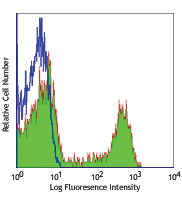
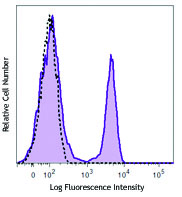
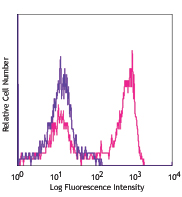

Compare Data Across All Formats
This data display is provided for general comparisons between formats.
Your actual data may vary due to variations in samples, target cells, instruments and their settings, staining conditions, and other factors.
If you need assistance with selecting the best format contact our expert technical support team.
-
Purified anti-rat CD3
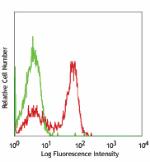
LOU rat splenocytes stained with purified 1F4, followed by a... -
FITC anti-rat CD3
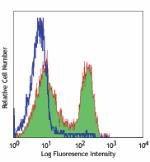
LOU rat splenocytes stained with 1F4 FITC -
PE anti-rat CD3
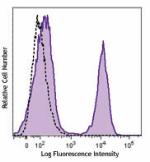
Lewis rat splenocytes were stained with CD3 (clone 1F4) PE (... -
Alexa Fluor® 488 anti-rat CD3
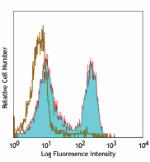
LOU rat splenocytes stained with 1F4 Alexa Fluor® 488 
Rat frozen spleen section was fixed with 4% paraformaldehyde... -
Alexa Fluor® 647 anti-rat CD3
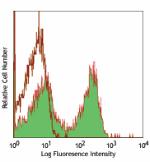
LOU rat splenocytes stained with 1F4 Alexa Fluor® 647 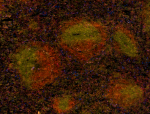
Rat frozen spleen section was fixed with 4% paraformaldehyde... -
APC anti-rat CD3
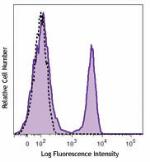
Lewis rat splenocytes were stained with CD3 (clone 1F4) APC ... -
Ultra-LEAF™ Purified anti-rat CD3
-
PerCP/Cyanine5.5 anti-rat CD3
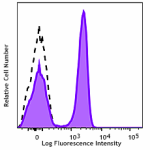
Lewis rat splenocytes were stained with CD3 (clone 1F4) Per... -
PE/Cyanine5 anti-rat CD3
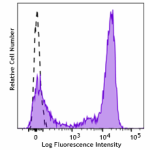
Lewis rat splenocytes were stained with anti-rat CD3 (clone ... -
PE/Cyanine7 anti-rat CD3
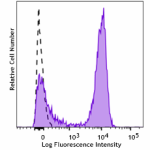
Lewis rat splenocytes were stained with anti-rat CD3 (clone ... -
Spark Violet™ 423 anti-rat CD3
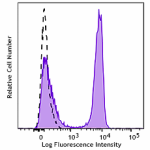
Lewis rat splenocytes were stained with anti-rat CD3 (clone ...
 Login/Register
Login/Register 













Follow Us